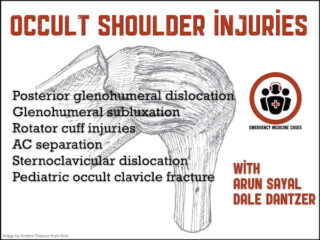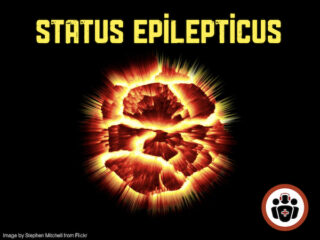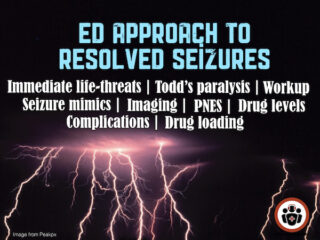
Ep 136 Occult Shoulder Injuries and Proximal Humerus Fractures
Dr. Arun Sayal and Dr. Dale Dantzer answer questions such as: What should be included in the list of key occult shoulder injuries that we should have in our back pockets when we are faced with a patient who has injured their shoulder and the x-ray appears normal? Which proximal humerus fractures are likely to require surgical management? Which shoulder injuries require a simple sling vs Velpeau sling vs collar and cuff vs sugar tong splint? When is an ultrasound of the shoulder indicated and how should they be interpreted? What is the best x-ray view to diagnose a sternoclavicular dislocation? What are the surgical indications for clavicle fractures? and many more...
Ep 135 Commonly Missed or Mismanaged Shoulder Injuries – Approach and Glenohumeral Dislocations
Dr. Arun Sayal and Dr. Dale Dantzer answer questions such as: How do we know we have adequate shoulder x-ray views? How can we best remember the differential diagnosis of an orthopedic extremity emergency with a normal x-ray? What is the quickest and best way to test neurologic status of patients with shoulder injuries? Why is axillary view of the shoulder so valuable? What is the biggest myth when it comes to the mechanism of injury for posterior glenohumeral shoulder dislocations? What physical exam maneuvers increase suspicion for posterior glenohumeral dislocation? What are the subtle findings on x-ray we should look for in patients with suspected posterior glenohumeral dislocation? What is the preferred first line reduction technique for posterior shoulder dislocation? What are the most common and consequential pitfalls in the management of anterior shoulder dislocations? and many more...
Ep 134 Shift Preparation: Pre-gaming with Rob Orman
The question is: how do we best mentally and physically prepare for an ED shift? Dr. Rob Orman, master educator and fellow podcaster joins Anton to discuss a few options...
Ep 133 Emergency Management of Status Epilepticus
Among the presentations seen in the ED, few command the same respect as status epilepticus. It is, in itself, both a diagnostic dilemma and, at times, a therapeutic nightmare. There’s a reason it’s the very first domino to fall in the dreaded sequence “seizure, coma, death”. Status epilepticus can be nuanced to manage. Sure, most seizures self-abort or love an IV dose of lorazepam, but ask anyone who’s been down the propofol route, and they’re not likely to have forgotten the time they stared down a patient who just...would...not....stop...
Ep 132 Emergency Approach to Resolved Seizures
What is the essential list of immediate life threats with specific antidotes that we must know for the ED patient with a seizure? What are the key elements for distinguishing a true seizure from syncope? From Psychogenic Non-Epileptic Seizure (PNES)? From TIA? From migraine? How do you distinguish Todd's Paralysis from TIA or stroke? What are indications for lactate and troponins in patients who present with a seizure? Do all patients with first time unprovoked seizures require anti-seizure medication in the ED? What is the preferred anti-seizure medication and route for ED loading for the patient with a first time seizure? Which patients who present with seizure require a CT head in the ED? What are indications and ideal timing for EEG for patient who present to the ED with seizure? and many more...
Ep 131 PEA Arrest, PseudoPEA and PREM – With Simard and Weingart
Rob Simard of POCUS Cases fame and Scott Weingart go beyond ACLS and guide you through the complex world of PEA. We discuss that the palpation technique is poor at determining whether or not a patient has a pulse, that the POCUS pulse is more accurate and as rapid compared to the palpation technique at determining whether or not a patient has a pulse, the difference between true PEA arrest, PseudoPEA and PREM, why epinephrine may be harmful in PEA, Weingart's chain of survival approach from PEA arrest to ROSC, four tools to help differentiate true PEA arrest from PseudoPEA, how to prevent long pauses in chest compressions using POCUS, EM Cases PEA arrest and PseudoPEA suggested dynamic algorithm, vasopressor choices in PseudoPEA, whether the "QRS wide vs narrow width" approach to PEA arrest underlying cause is useful or not and much more...







